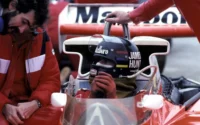British American Racing (BAR) was a British Formula One team that competed from 1999 to 2005. The team originated from the Tyrrell team and transitioned into BAR in the late 1990s.
Notable Team Members and Drivers
Craig Pollock: Founder and original team principal of BAR, instrumental in transitioning the Tyrrell team into BAR.
David Richards: Replaced Craig Pollock as team principal in 2002. Under his management, BAR saw substantial improvements, culminating in their successful 2004 season, finishing second in the 2004 Constructors’ Championship.
Jenson Button: Joined the team in 2003 and stayed through its transition to Honda. Button’s performances, including multiple podium finishes, helped the team secure second in the 2004 Constructors’ Championship.
Background
Named after its part-owner and sponsor, British American Tobacco, BAR is unique as the only constructor named after a tobacco sponsor, despite the common practice of tobacco companies sponsoring F1 teams.
BAR’s driver lineup included the 1997 champion Jacques Villeneuve, Ricardo Zonta, and Jenson Button.
In 2006, due to new tobacco regulations, the team was sold and rebranded as Honda Racing. Honda Racing then became Brawn GP in 2009 amidst the global economic crisis and subsequently transformed into Mercedes GP in 2010.
The team’s best season was in 2004 when they finished second in the Championship, behind Ferrari.
1997–1998
In 1997, Craig Pollock successfully persuaded BAR to contribute the majority of the £30 million required to purchase the Tyrrell Formula One team. Pollock, along with Adrian Reynard and Rick Gorne, held minority stakes. The acquisition was officially announced on December 2, 1997 but the team continued to compete as Tyrrell in 1998 before rebranding as BAR in 1999.
1999
In a disastrous debut season, BAR failed to score any points in the 1999 Constructors’ Championship. Despite the car’s relative speed and frequent midfield qualifying positions, chronic unreliability plagued the team. Jacques Villeneuve started the year with 11 consecutive retirements and did not finish a race until the 1999 Belgian Grand Prix in August. Ricardo Zonta missed three races due to injury and managed a best finish of 8th. Mika Salo, who substituted for Zonta during his absence, secured the team’s best finish of the season with a 7th place.
2000
During the 1999 season, BAR announced a partnership with Honda to supply engines starting in 2000. This deal included not only engine supply but also the integration of Honda staff into the team’s operations at their Brackley base. Initially, Honda had intended to enter Formula One as a factory team but decided against it. This marked Honda’s direct return to Formula One for the first time since 1992. BAR shared Honda engines with Jordan Grand Prix, who were using Mugen Honda units at the time. By the following year, Jordan also received factory Honda engines, sparking a competition between BAR and Jordan for exclusive long-term access to Honda power.
The car for the 2000 season was once again designed in collaboration with Adrian Reynard, despite rumoured tensions between him and team principal Craig Pollock. At the launch of the 002 car, Pollock described the season as an opportunity to “wipe the slate clean” after their disappointing debut year, acknowledging the numerous mistakes made.
In 2000, the Honda-powered BAR demonstrated significant improvement, with much better reliability than the previous year. However, despite this progress, the team only managed a best finish of 4th, and the elusive victory promised in 1999 did not materialise. The team finished 5th in the 2000 Constructors’ Championship. This progress was sufficient to convince Jacques Villeneuve to remain with the team.
2001
In 2001, Jacques Villeneuve achieved two podium finishes for BAR, but both his and new teammate Olivier Panis lacked consistent results.
2002
Facing pressure from British American Tobacco, Craig Pollock resigned just before the launch of the 2002 car and was replaced by David Richards as team principal. Richards’ company, Prodrive, was awarded a five-year management contract to run BAR. Prodrive and BAT had a prior relationship, with BAT sponsoring Subaru’s World Rally Championship team, which Prodrive operated.
The 2002 season was a transitional period for BAR. A significant portion of the workforce was reduced, and technical director Malcolm Oastler and designer Andrew Green departed. Jacques Villeneuve continued to struggle to score points, and Olivier Panis also failed to meet expectations. Despite finishing behind Honda’s other team, Jordan, in both 2001 and 2002, BAR secured a deal to become Honda’s exclusive team for 2003.
2003
For the 2003 Formula One season, BAR brought in Jenson Button to replace Olivier Panis. Contract negotiation disputes between Jacques Villeneuve and team principal David Richards led to Villeneuve being replaced by Japanese driver Takuma Sato before the season ended, aligning with Honda’s preference for having Japanese drivers to boost publicity in their home country. Jenson Button led a race for the first time at the 2003 United States Grand Prix. However, the team struggled throughout the season due to its use of Bridgestone tyres. During the off-season, BAR switched to rival tyre manufacturer Michelin.
2004
In 2004, BAR experienced a significant upswing in performance, with Jenson Button achieving numerous podium finishes and securing the team’s first pole position at the 2004 San Marino Grand Prix. BAR finished the season in 2nd place in the 2004 Constructors’ Championship, behind Ferrari, though a race win still eluded them.
Throughout the season, a contract dispute with Williams threatened to overshadow BAR’s on-track success. Both teams claimed to have a valid contract with Button for 2005. The matter was eventually resolved by the Contract Recognition Board, which ruled in favour of BAR. As a result, Button remained with BAR for 2005 but signed a contract to join Williams for 2006.
Amid increasing restrictions on tobacco advertising in Formula One, rumours circulated that BAT might sell the team. In mid-November 2004, BAR announced that Honda had purchased a 45% stake in the team. As part of the deal, David Richards stepped down as team principal, replaced by Nick Fry. Additionally, Prodrive’s management contract was terminated early.
2005
The 2005 season began poorly for BAR, with struggles in the early “flyaway” races. Just as they started to show competitiveness at the 2005 San Marino Grand Prix, BAR Honda was disqualified for running illegal cars. The allegation was that the cars could race with a total weight below the minimum required 605 kg (1323 lb). BAR argued that their cars required at least 6 kg (13 lb) of fuel to function properly, keeping them above the minimum weight during the race but not necessarily during post-race scrutineering.
The FIA and the court disagreed with BAR’s interpretation. In addition to the disqualification, BAR was banned for two races, including the lucrative 2005 Monaco Grand Prix. Initially, BAR considered challenging the decision in a civil court but eventually accepted the verdict. FIA President Max Mosley deemed the sanction lenient, as he had advocated for a season-long ban but could not prove deliberate intent to cheat, unlike Tyrrell’s case in 1984.
Upon their return at the 2005 European Grand Prix, BAR struggled to regain form. Unlike the previous season, BAR didn’t score any points until the 2005 French Grand Prix halfway through the season. The team’s use of Michelin tyres also caused them to withdraw from the 2005 United States Grand Prix. Takuma Sato had a particularly difficult season, scoring only one point, and his contract was not renewed. He was replaced by former Ferrari driver Rubens Barrichello for the new Honda team.
Jenson Button scored in each of the last 10 races of the season, achieving two podium finishes. A highlight was his pass on Jacques Villeneuve at the fast Pouhon corner at Spa-Francorchamps, in the rain, overtaking around the outside.
By the end of 2005, Honda acquired 100% ownership of BAR from British American Tobacco, fulfilling their goal of becoming a full F1 manufacturer team. Additionally, Jenson Button’s Williams contract was bought out for $30 million, and he signed a multi-year contract with Honda.
British American Racing Formula One World Championship Records
| First entry | 1999 Australian Grand Prix |
|---|---|
| Races entered | 118 (117 starts) |
| Engines | Supertec, Honda |
| Constructors’ Championships | 0 (best finish: 2nd, 2004) |
| Drivers’ Championships | 0 (best finish: 3rd, 2004, Jenson Button) |
| Race victories | 0 (best finish: 2nd, 2004 San Marino, Monaco, German and Chinese Grands Prix) |
| Podiums | 15 |
| Points | 227 |
| Pole positions | 2 |
| Fastest laps | 0 |
| Final entry | 2005 Chinese Grand Prix |
Entrant Names
| Year | Name |
|---|---|
| 1999 | British American Racing |
| 2000–2005 | Lucky Strike BAR Honda |
British American Racing Constructors’ Championship Results
| Year | Chassis | Engine | Tyre | No. | Driver | Rounds | Points | WCC |
|---|---|---|---|---|---|---|---|---|
| 1999 | 01 | Supertec FB01 3.0 V10 | B | 22 | Jacques Villeneuve | All | 0 | — |
| 23 | Ricardo Zonta | 1–2, 6–16 | ||||||
| Mika Salo | 3–5 | |||||||
| 2000 | 002 | Honda RA000E 3.0 V10 | B | 22 | Jacques Villeneuve | All | 20 | 5th |
| 23 | Ricardo Zonta | All | ||||||
| 2001 | 003 | Honda RA001E 3.0 V10 | B | 9 | Olivier Panis | All | 17 | 6th |
| 10 | Jacques Villeneuve | All | ||||||
| 2002 | 004 | Honda RA002E 3.0 V10 | B | 11 | Jacques Villeneuve | All | 7 | 8th |
| 12 | Olivier Panis | All | ||||||
| 2003 | 005 | Honda RA003E 3.0 V10 | B | 16 | Jacques Villeneuve | 1–15 | 26 | 5th |
| Takuma Sato | 16 | |||||||
| 17 | Jenson Button | All | ||||||
| 2004 | 006 | Honda RA004E 3.0 V10 | M | 9 | Jenson Button | All | 119 | 2nd |
| 10 | Takuma Sato | All | ||||||
| 2005 | 007 | Honda RA005E 3.0 V10 | M | 3 | Jenson Button | 1–4, 7–19 | 38 | 6th |
| 4 | Takuma Sato | 1–4, 7–19 | ||||||
| Anthony Davidson | 2 |
Source: Wikipedia.com and fandom.com



